
Definition and Components of Event Presentations
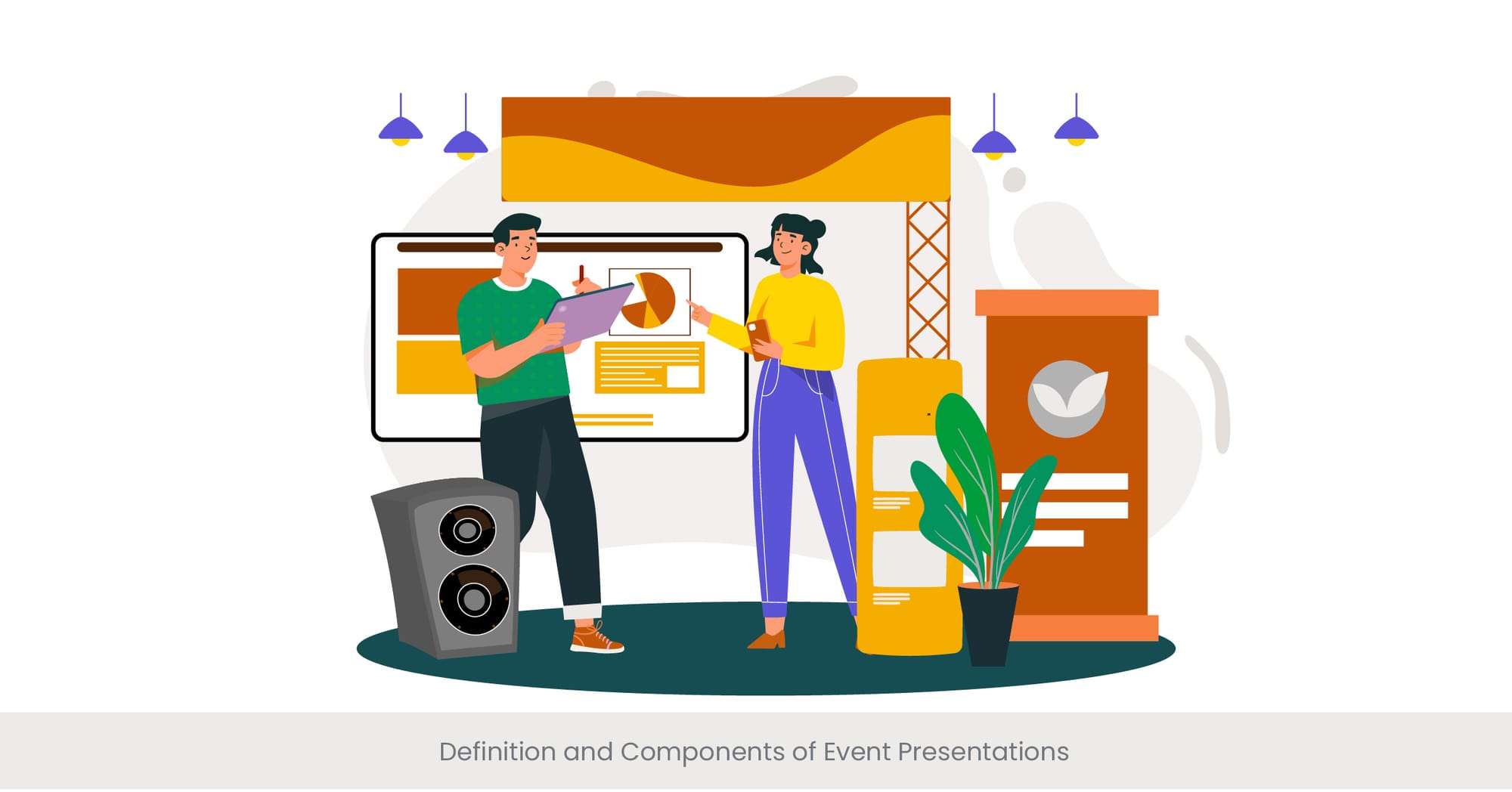
Unlocking the Essentials of Event Presentations
Event presentations are a pivotal element in the tapestry of event production, serving as a bridge between the message and the audience. They encompass a wide range of formats, from keynote speeches to multimedia displays, each tailored to enhance the event's theme and objectives. The core components of event presentations include audio visual content creation, which plays a crucial role in engaging the audience, visual effects that add depth and dimension to the presentation, and the strategic use of technology to ensure a seamless delivery. Understanding these components is essential for anyone involved in event content creation and production, as they collectively contribute to the success of the event.
A Historical Perspective
The evolution of event presentations can be traced back to the early days of public speaking and theatrical performances, where the spoken word and manual stagecraft were the primary tools of engagement. However, with the advent of audio visual technology, the landscape of event presentations underwent a significant transformation. The introduction of projectors, sound systems, and later, digital media, marked a new era in event production. These technologies enabled the creation of more dynamic and immersive presentation environments, setting new standards for audience engagement.
Real-World Applications
Today, audio visual production is at the heart of event presentations. From corporate live events to large-scale conferences, the ability to integrate audio visuals, such wireless microphones as equipment needs as wireless microphones for clear speech transmission, and visual effects, like lighting and projections to set a certain mood, has become indispensable. For instance, at a recent technology conference, the use of high-definition video presentations alongside live demos showcased the potential of combining traditional speaking formats with cutting-edge AV technology to captivate and educate the audience.
Establishing Credibility Through References
The impact of audio visual components in event presentations is well-documented. Studies have shown that presentations utilizing both audio and visual elements are significantly more effective in retaining audience attention compared to those that use only one sensory channel. According to a report by the Audiovisual and Integrated Experience Association (AVIXA), live events incorporating professional AV services not only achieve higher engagement rates but also leave a lasting impression on attendees, underlining the critical role of AV in the success of modern Events.
Historical Evolution of Presentations in Event Settings

Tracing the Roots of Event Presentations
The journey of presentations within event settings has evolved dramatically, from humble beginnings to the sophisticated, technology-driven spectacles we witness today. Initially, event presentations were predominantly oral traditions, relying on the power of speech to inform, entertain, and inspire audiences. These presentations were straightforward, focusing on direct communication without the aid of modern technology. The essence of these early presentations laid the foundation for the development of more complex and engaging formats that would follow.
The Technological Revolution
The advent of the 20th century marked a significant turning point in the evolution of event production and presentations, with the introduction of audio visual equipment. Slide projectors, filmstrips, and eventually, video projectors transformed the way information was delivered at live events. This era ushered in a new age of audio visual event production, where visuals and sound effects began to play a pivotal role in enhancing the presentation experience at live events, making it more dynamic and immersive for attendees.
A New Age of Engagement
The late 20th and early 21st centuries witnessed a rapid advancement in digital technology, fundamentally altering the landscape set expectations of event presentations. High-definition video, sophisticated sound systems, and interactive technologies enabled presenters and production companies to deliver content in ways that were previously unimaginable. Events became multimedia experiences, with presentations that could captivate audiences through a combination of visual, auditory, and even tactile elements. This period also saw the rise of virtual and hybrid events, further expanding the possibilities for presentation formats and audience reach.
Validating Evolution with Evidence
Research and surveys from leading industry bodies, such as the live Events Industry Council and the Professional Convention Management Association (PCMA), highlight the transformational impact of technology on event presentations. They note an increasing demand for innovative audio visual services, underscoring the shift towards more engaging and interactive formats. Additionally, a study published in the "Journal of Event and Experience Studies" illustrates how the integration of digital technology in event presentations has significantly improved audience engagement and satisfaction, affirming the ongoing evolution towards more immersive and interactive event experiences.
Common Types of Presentations in the Event Industry

Diverse Formats for Every Occasion
The event industry boasts a wide array of presentation types and venues, each serving different purposes and catering to various audience needs. From keynote speeches that inspire and motivate, to workshops and seminars designed for educational purposes, the diversity present in presentation formats is a testament to the dynamic nature of events. Notably, panel discussions facilitate a multifaceted exploration of topics, while product demonstrations offer hands-on experience, showcasing the practical application of goods or services. This variety ensures that events can be tailored to achieve specific objectives, no matter whether it's to inform, educate, or entertain.
Exploring the Roots of audio visuals Presentation Diversity
The origins of this diversity can be traced back to the evolution of event settings past events themselves. As events grew in complexity, so too did the need for presentations that could adapt to varying contexts and audience expectations. Historical advancements in audio visual production played a significant role in this evolution, enabling more interactive and engaging formats. This progression from traditional speeches to interactive videos, workshops and beyond reflects a broader trend towards creating more personalized and impactful event experiences.
Spotlight on Innovation and Engagement
Today's event presentations leverage cutting-edge technology to enhance engagement and deliver memorable experiences. For instance, augmented reality (AR) presentations allow attendees to interact with virtual elements in real-time, adding a new dimension to product demonstrations. Similarly, live polling and Q&A sessions during panel discussions harness technology to foster a two-way dialogue between speakers and the audience, making the experience more interactive and inclusive.
Underpinning Trends with Data
Industry reports highlight the growing importance of innovative presentation formats in achieving event success. According to a survey by the Event Marketing Institute, events utilizing interactive presentation formats report higher levels of attendee satisfaction and engagement. Furthermore, research from the Audiovisual and Integrated Experience Association (AVIXA) underscores the pivotal role of audio visual services in enhancing presentation quality, illustrating the critical connection between AV technology and service and the effectiveness of diverse presentation and service types in the event industry.
Purposes and Objectives of Audio Visual Production Presentations in Events
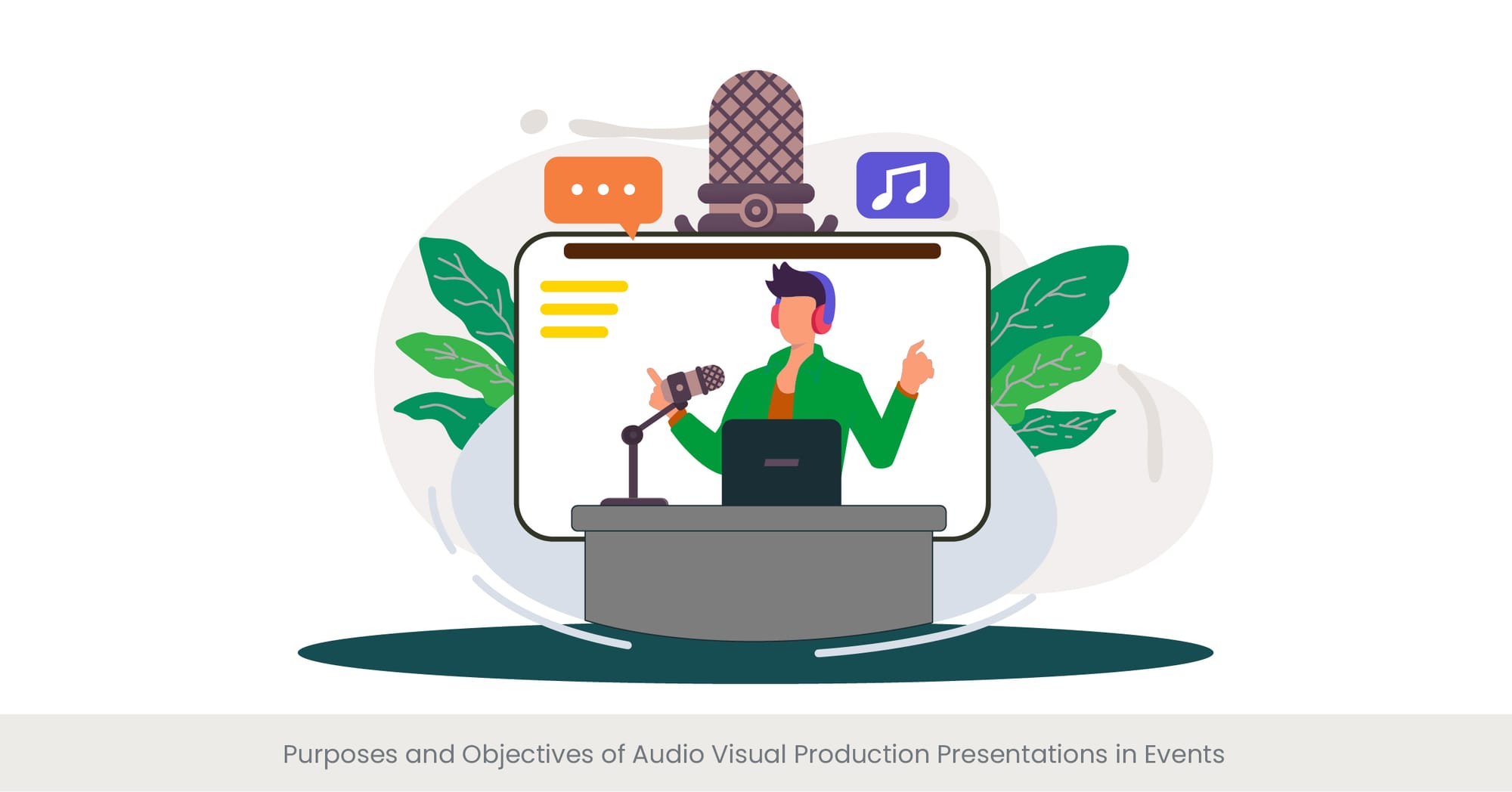
Driving Event Success Through Purposeful Presentations
Presentations at corporate events can serve multifaceted purposes and objectives, central to the success and impact of the event itself. They can inform, persuade, educate, or entertain, depending on the event's goals. For instance, corporate events might leverage presentations to unveil new products, share strategic insights, or foster team-building. Educational seminars, on the other hand, focus on knowledge transfer and skill development. Each presentation type is designed with specific outcomes in mind, ensuring that the content delivered aligns with the overarching objectives of the event.
Foundations of audio visual Services Presentation Objectives
The objectives behind event presentations have evolved as the landscape of the event industry has changed. Historically, presentations served primarily to inform or entertain. However, as the industry has grown and diversified, so too have the purposes of presentations. Today, they are also used to build communities, foster networking, and drive social engagement. This shift reflects a broader understanding of the value events can provide, extending beyond mere information dissemination to creating lasting impacts on attendees.
Realizing Objectives Through Innovative Formats
The realization of these objectives is increasingly dependent on the innovative use of audio visual production companies for content and services. For example, audio visual production enhances the delivery of key messages, making them more memorable and impactful. In educational workshops, AV technology facilitates interactive learning experiences, while in product launches and stage show, visual effects, set design and sound design can create a captivating showcase. These technologies are not just tools but integral components that define the success of modern event presentations.
Evidence of Impact
The effectiveness of purpose-driven presentations in achieving event objectives is well-documented. Studies indicate that events utilizing targeted presentation formats see higher levels of attendee engagement and satisfaction. For instance, research published in the "International Journal of Event and Festival Management" highlights that presentations tailored to specific audience needs and preferences significantly increase the perceived value of the event. Additionally, data from AVIXA reveals that events incorporating professional audio visual services tend to outperform others in terms of attendee feedback and overall success, underscoring the critical role of AV in fulfilling the diverse objectives of event presentations.
The Role of Presentations in Event Engagement and Experience

Enhancing Engagement Through Dynamic Presentations
Presentations play a pivotal role in shaping the engagement and overall experience of event attendees. They act as the primary conduit through which information, emotions, and values are conveyed, making their design and execution critical for the success of any event. Through compelling storytelling, interactive elements, and high-quality audio visual content, presentations can captivate the audience, fostering a deeper connection with the event's themes and objectives. This engagement is not passive; it invites participants to immerse themselves fully, transforming their event experience from mere observation to active participation.
Historical Context and Evolution
The importance of presentations in enhancing engagement has been recognized since the earliest days of event planning. However, the methods and technologies used have evolved significantly. Where once engagement might have been facilitated through simple slide shows or speeches, today's events often incorporate a broad array of audio visual services, from immersive video installations to interactive digital kiosks. This evolution reflects a broader industry trend towards creating more memorable, experiential events that engage attendees on multiple levels.
Case Studies of Engagement Success
Real-world examples abound of events where presentations have significantly boosted engagement and enriched the attendee experience. For instance, at a recent technology expo, a series of live, interactive product demonstrations set up using augmented reality technology allowed attendees to experience new gadgets firsthand, leading production company to record levels of participant interaction and satisfaction the next event. Similarly, at a medical conference, presentations that included real-time polling and Q&A sessions via a dedicated event app saw higher levels of attendee engagement and provided valuable feedback to speakers and organizers.
Supporting Research and Data
The link between dynamic presentations and enhanced event engagement is supported by extensive research. Studies have shown that events utilizing innovative audio visual production techniques, such as 3D projections and surround sound, not only attract larger audiences but also promote higher levels of information retention and satisfaction. Furthermore, a survey conducted by the Events Industry Council revealed that over 80% of event planners believe that engaging presentations are critical to an event's success, highlighting the industry-wide recognition of their value.
Key Elements of a Audio Visual Production Successful Event Presentation
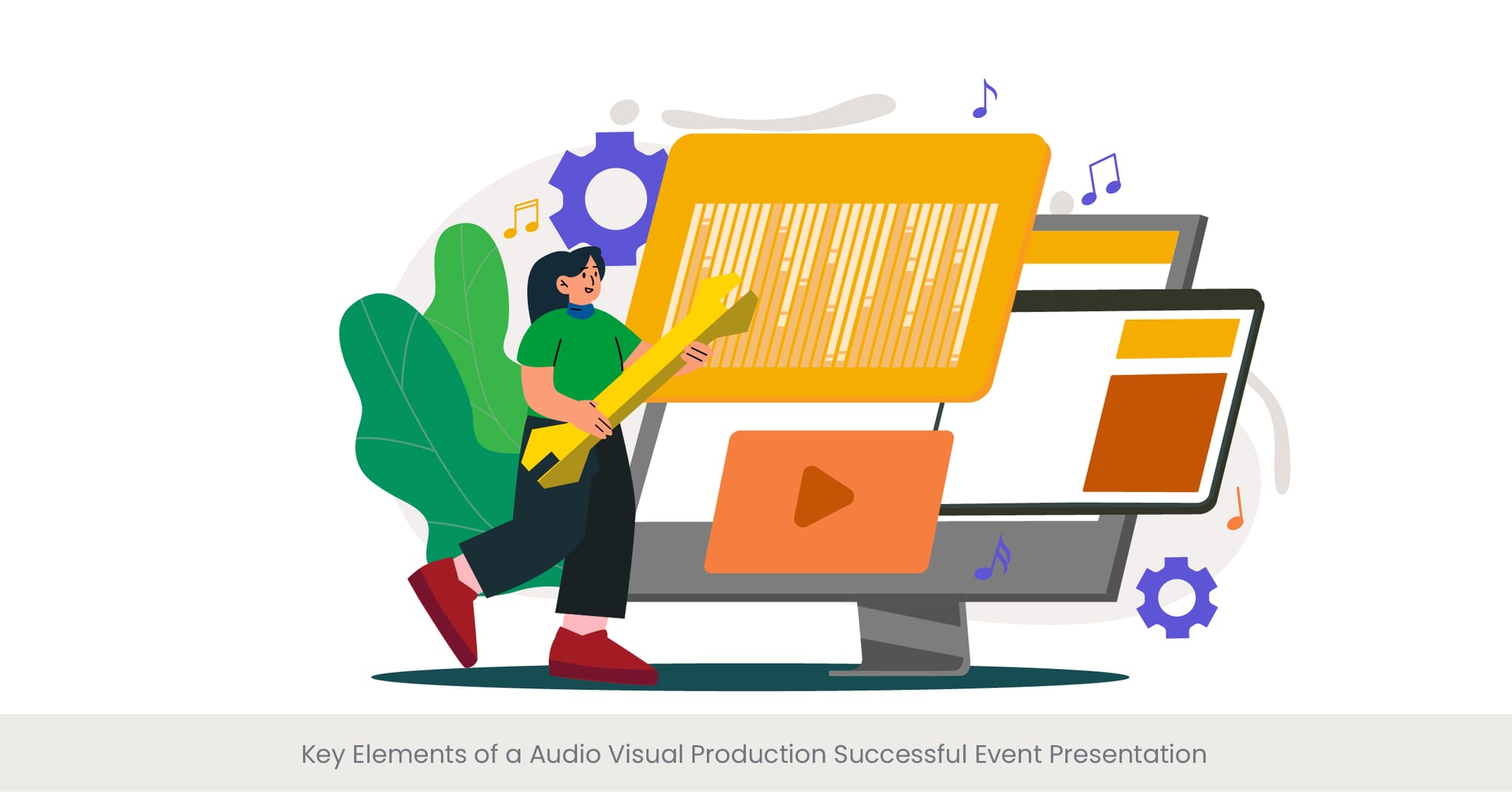
Crafting Memorable Moments Through Mastery
The success of an event presentation hinges on several key elements, each meticulously designed to capture the audience's attention, convey the intended message, and leave a lasting impression. At the heart of a successful presentation lies a clear and compelling narrative, supported by high-quality audio visual content that enhances the storytelling experience. Equally important are the engagement strategies employed, such as interactive polls or Q&A sessions, which foster a participatory atmosphere. Furthermore, the seamless integration of technology not only amplifies the delivery but also ensures that the presentation resonates with a technologically savvy audience.
Collaborator meeting presentations are key to fostering teamwork and aligning goals during events. These presentations should be interactive, utilizing real-time polls or feedback loops to ensure participation. Integrating multimedia elements enhances the overall experience, encouraging active involvement and fostering deeper connections among team members.
Read Our Blog for Presentation Trends & Tips - Explore Blog
The Building Blocks of Presentation Excellence
A successful event presentation is underpinned by thorough planning and a deep understanding of the audience's preferences and needs. This includes a well-structured agenda that flows logically, the use of visuals and sound effects to reinforce key points, and the adaptability of content to suit different learning styles and engagement levels. Additionally, the presenter's ability to connect with the audience, through both content and delivery, plays a crucial role in the presentation's effectiveness. This connection can be achieved through the use of storytelling techniques, humor, and the sharing of personal experiences or insights that add depth and authenticity to the presentation.
Illustrating Success Through Examples
Examples of successful team and event presentations abound across clients and various industries. For instance, a keynote presentation at a major business conference that utilized a combination of compelling storytelling, cutting-edge visual effects, and live audience interaction stands out as a benchmark for excellence. Similarly, an educational workshop that incorporated real-world case studies, interactive exercises, and immediate feedback mechanisms effectively engaged participants, enhancing their learning experience and overall satisfaction with the team and event.
Validating with Industry Insights
Research and feedback from the events industry consistently highlight the critical importance of these key elements in successful event presentations. Surveys conducted among event attendees reveal that presentations which incorporate interactive elements and utilize advanced audio visual services are more likely to be rated as engaging and impactful. Additionally, industry reports from organizations such as the Audiovisual and Integrated Experience Association (AVIXA) underscore the growing expectation for high-quality AV production in events, linking it directly to the success of presentations in capturing audience attention and delivering memorable experiences.
Company milestone event decks celebrate achievements and future aspirations while conveying key information about past successes. These decks should emphasize storytelling, combining emotional and data-driven elements to resonate with stakeholders. Effective milestone presentations reinforce company pride and commitment, leaving a lasting impression on the audience and enhancing brand loyalty.
Explore Our Case Studies for Event Success!
View Case Study - Driving Forward: Unveiling JSW MG Motor India Private Limited
Event Presentation vs. Traditional Presentation: Understanding the Distinctions
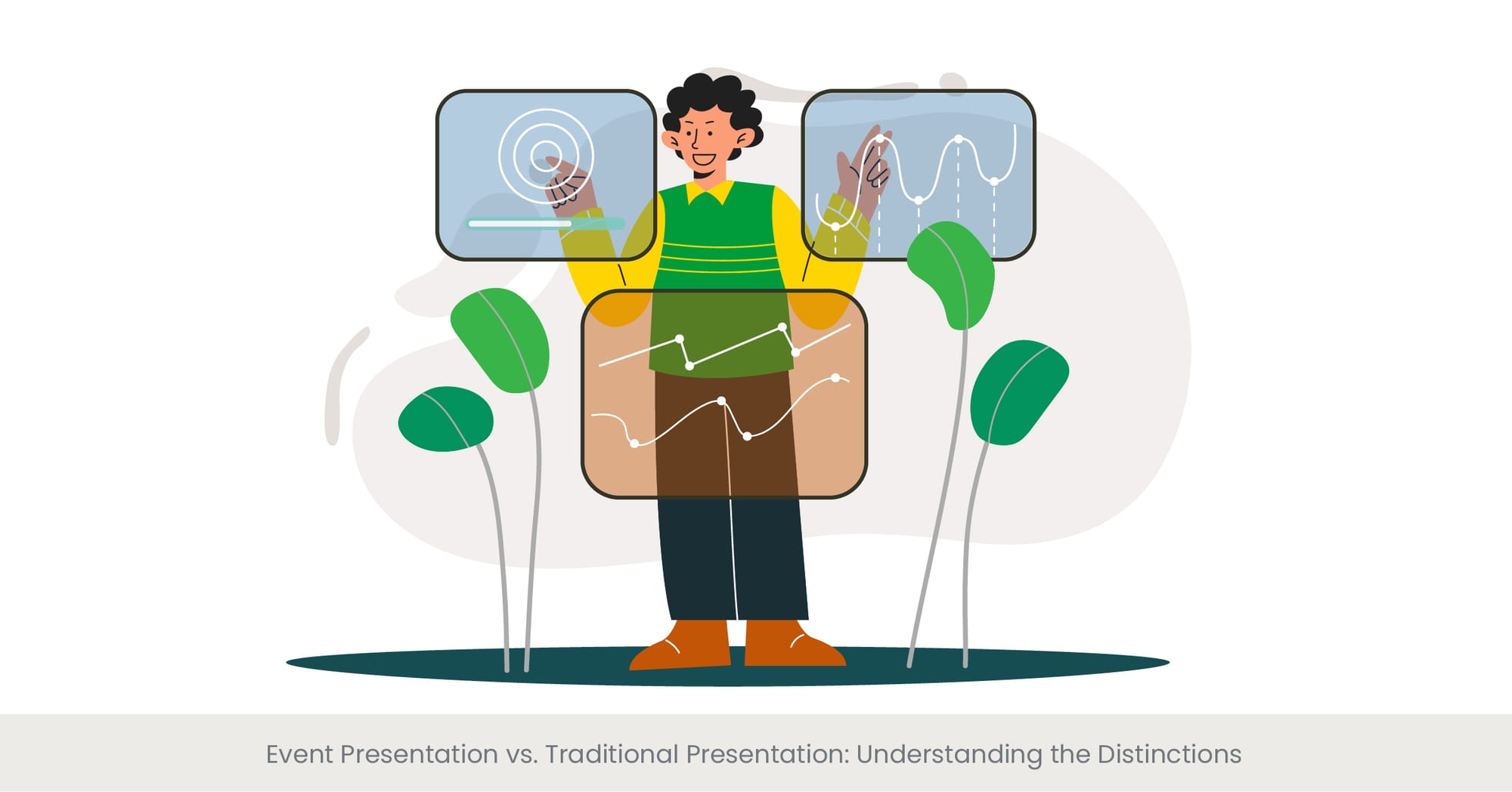
Navigating the Spectrum of Presentation Styles
Event presentations and traditional presentations occupy distinct spaces within the realm of public speaking and communication, each characterized by unique elements tailored to their specific contexts. The primary distinction lies in their purpose and setting. Event presentations, often part of larger gatherings like conferences, seminars, or events, are designed to engage, entertain, and inform a collective audience with a shared interest. They typically incorporate extensive audio visual production elements, interactive components, and are crafted to enhance the overall event experience. In contrast, traditional presentations might be more informational or educational, directed towards smaller, more defined audiences, with a focus on content delivery over audience interaction.
Corporate event presentations focus on capturing attention and driving engagement in large, professional settings. These presentations often leverage cutting-edge audio-visual technology, immersive storytelling, and audience interaction. Unlike traditional presentations, corporate events aim to create memorable experiences that reflect the organization’s culture, values, and goals in a dynamic way.
The Evolution of Presentation Approaches
Historically, traditional presentations have relied heavily on direct communication and minimalistic aids, such as slideshows, videos or physical handouts. However, the advent of new technologies and the rise of the events industry have pushed the boundaries of what presentations can achieve. Event presentations now often leverage state-of-the-art audio visual services, immersive storytelling, and dynamic engagement techniques to captivate audiences. This evolution reflects a broader shift towards creating experiences that are not only informative but also memorable and impactful.
Illustrative Examples of Distinction
A clear example of this distinction can be seen in the comparison between a standard corporate presentation to a team of clients and stakeholders, which might focus on financial reports and strategic plans for production company, versus a product launch at a trade show, which could utilize interactive displays, live demonstrations, and engaging narratives to capture the essence of the new product. The latter not only conveys information but also creates an experience that resonates with attendees on an emotional level, encouraging deeper connection and retention of the presented content.
Product unveiling presentations require a high level of creativity and technical execution to captivate audiences. Combining live demonstrations, engaging narratives, and visually compelling elements, these presentations aim to create buzz and excitement around a new product. The goal is to build anticipation and drive immediate interest in the product's features.
Empirical Support and Industry Perspectives
Studies and industry feedback have highlighted the growing importance of immersive and interactive elements in event presentations. According to a report by the Event Marketing Institute, presentations that employ advanced AV technologies and interactive elements see significantly higher engagement rates and attendee satisfaction. Furthermore, a survey conducted by the Professional Convention Management Association (PCMA) found that event organizers and presenters increasingly prioritize the creation of unique, experience-driven presentations over traditional, lecture-style formats. This shift underscores the critical role of innovation in meeting and exceeding audience expectations in the modern event landscape.
Cultural Considerations in Event Presentations

Bridging Cultures Through Thoughtful Presentation Design
In the global landscape of events, understanding and integrating cultural considerations into event presentations is paramount for fostering inclusivity and resonance with a diverse audience. Cultural sensitivity in presentations can enhance the attendee experience, ensuring that content is accessible, respectful, and engaging for participants from various backgrounds. This involves careful selection of language, imagery, examples, and storytelling techniques that acknowledge and celebrate cultural diversity. Tailoring presentations to reflect cultural nuances can significantly impact the effectiveness and reception of the message being conveyed.
The Foundation of Cultural Awareness
The importance of cultural considerations in event presentations has grown as events have become more international in scope. The historical and present evolution of event presentations from local to global stages necessitates a deep understanding of cultural differences and similarities. Presenters must navigate these complexities with sensitivity and awareness, avoiding stereotypes and generalizations, to ensure their message is both universal and specific enough to engage attendees across cultures.
Real-World Applications and Success Stories
Successful examples of culturally considerate event presentations include international conferences where speakers use multilingual support and create culturally relevant examples to connect with the audience. Another instance is events that incorporate local traditions, ideas and customs into their presentations past events, creating a welcoming and inclusive atmosphere for all attendees present.
These practices not only enhance the event experience but also demonstrate respect and appreciation for the diversity of the audience. Research underscores the value of cultural sensitivity in event presentations. Studies indicate that presentations tailored to the cultural backgrounds and expectations of attendees result in higher levels of engagement and satisfaction.
According to a survey by the International Association of Conference Centres (IACC), events and venues that incorporate cultural considerations into their planning process and presentation content are more likely to have successful events achieve their objectives and leave a positive, lasting impression on participants.
Get Expert Guidance for Your Corporate Events
Contact Our Experts
Adapting Presentations for Virtual and Hybrid Event Platforms
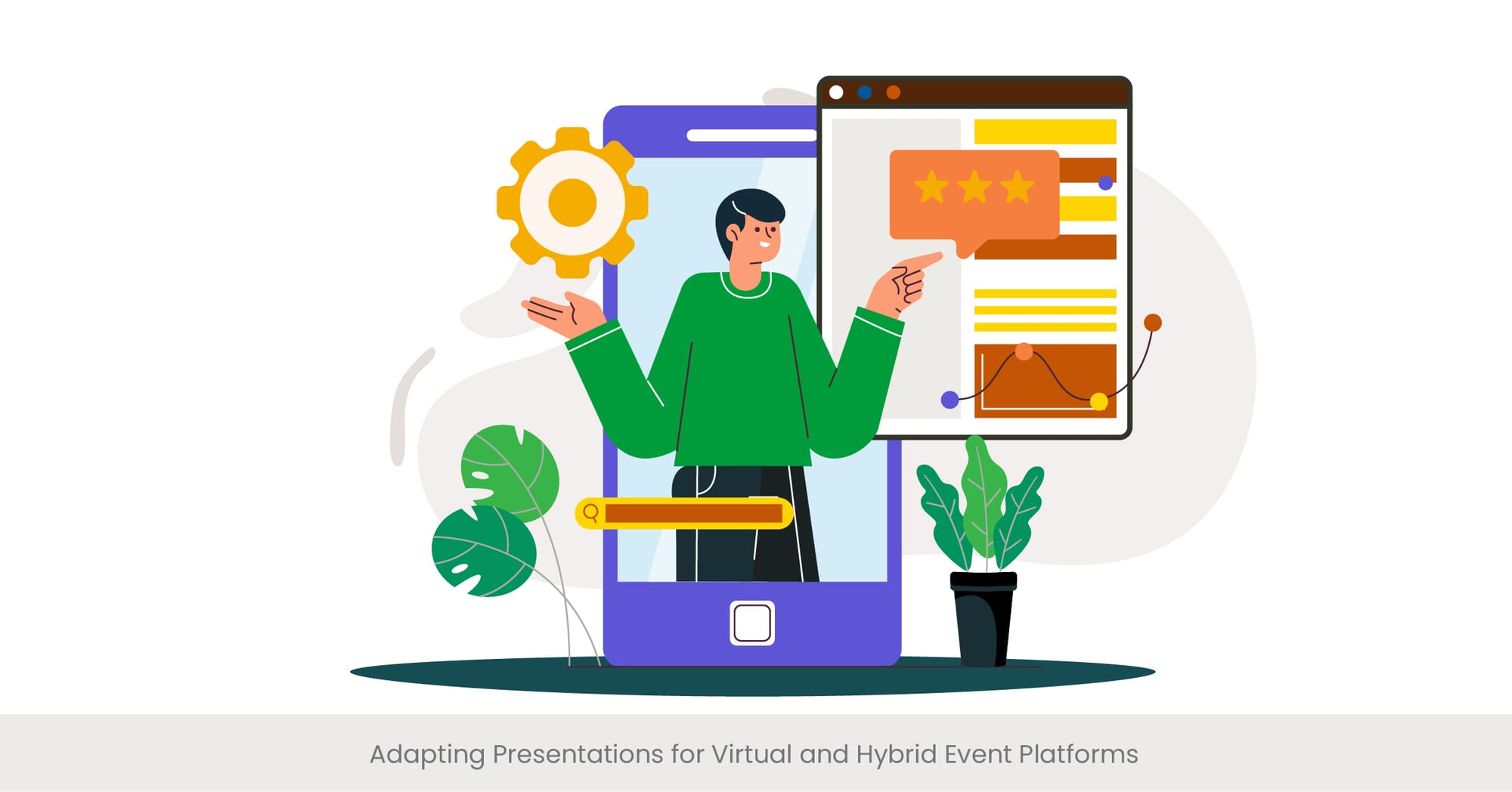
Embracing the Digital Shift in Event Presentations
The transition to virtual and hybrid event platforms has necessitated a significant adaptation in how presentations are designed and delivered. These formats combine the reach and accessibility of virtual environments with the intimacy and engagement of in-person events, requiring presenters to rethink their strategies to effectively engage a dispersed audience. Key to this adaptation process is the utilization of advanced audio visual production techniques, interactive stage elements, and digital tools that facilitate real-time participation, ensuring that the virtual audience is as engaged and connected as those physically present.
Historical Context and the Rise of Digital Events
The pivot from live events to virtual and hybrid events, accelerated by global circumstances such past events such as the COVID-19 pandemic, marks a significant evolution in the event industry. This shift has propelled the development and adoption of new technologies and methodologies for event presentations, with a focus on maintaining and enhancing attendee engagement in a virtual setting. The challenge has been to replicate the dynamic and interactive nature of live event presentations in a digital format, a task that has led to innovative solutions, ideas and practices.
Innovative Practices for Digital Engagement
Successful adaptation to virtual and hybrid platforms often involves creative uses of technology to capture and maintain audience interest. For example, incorporating live polls, Q&A sessions, and interactive breakout rooms can simulate the interactive experience of in-person events. Furthermore, the creative use of high-quality video content, virtual reality (VR) experiences, and augmented reality (AR) demonstrations can add a new layer of immersion, entertainment and engagement, making the digital event experience more compelling and memorable.
Supporting Data and Industry Trends
The effectiveness of adapted presentations in virtual and hybrid formats is supported by emerging data and trends within the event industry. Surveys and studies indicate that events incorporating interactive and immersive digital elements report higher levels of attendee satisfaction and engagement. A report by the Global Association of the Exhibition Industry (UFI) highlights that virtual and hybrid events offering engaging and interactive presentations have seen increased attendee numbers and positive feedback, underscoring the critical role of effective presentation adaptation in the success of digital events.
Incorporating Storytelling Techniques in Events Presentations
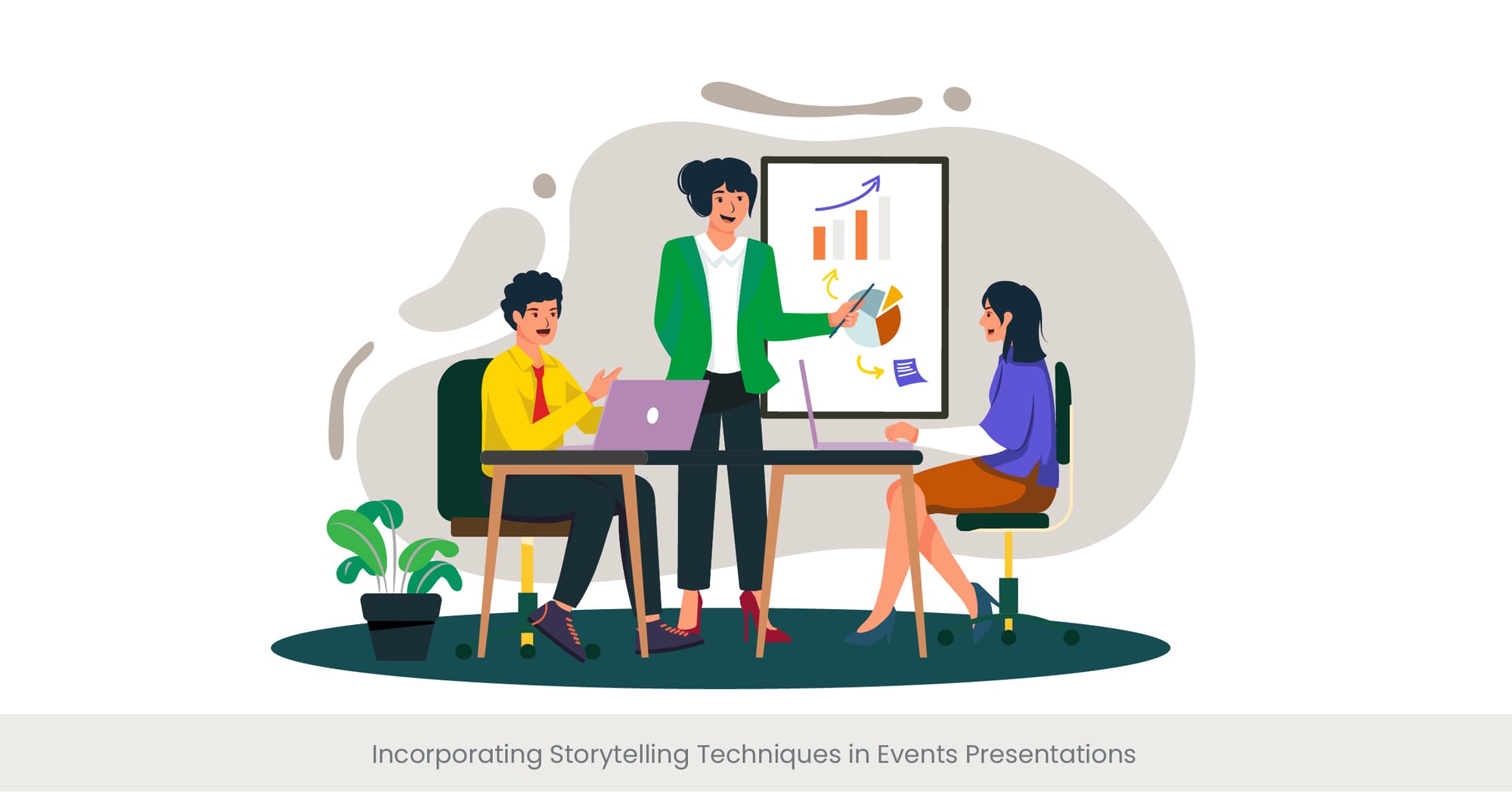
Elevating Engagement Through Narrative
Storytelling is a powerful tool in the arsenal of event presentation techniques, capable of transforming a standard presentation into an engaging, memorable experience. By weaving a narrative through the presentation, speakers can connect with their audience on a deeper level, eliciting emotional responses and forging a lasting memory of the event. Incorporating storytelling involves not just recounting anecdotes but structuring the entire presentation as a journey, with a clear beginning, middle, and end, enriched with relatable characters, challenges, and resolutions. This approach enhances the relevance and impact of the content, making complex information more accessible and engaging.
The Roots of Storytelling in Event Production Presentations
The use of storytelling in presentations harks back to ancient traditions of oral history and narrative arts, where stories were the primary means of conveying knowledge, culture, ideas and values. In the context of modern event presentations, storytelling techniques have been adapted to serve various purposes, from illustrating key points to further ideas and motivating change, demonstrating the timeless nature utmost importance of storytelling as a means of communication. As events have evolved, so too has the sophistication of storytelling and production methods, incorporating multimedia elements and interactive technologies to enrich the narrative experience.
Successful Implementations of Storytelling
Notable examples of effective storytelling in event presentations include keynote speeches that share the personal journey of the speaker, connecting their experiences to the broader themes of the event. Workshops and seminars that use case studies or success stories as narrative frameworks also demonstrate the power of storytelling in engaging audiences and facilitating learning. Additionally, the use of audio visual content, such as short films or animated sequences of videos and music, can bring stories to life, adding visual and auditory dimensions to the narrative.
Empirical Evidence and Industry Insights
Research underscores the effectiveness of storytelling in service of enhancing audience engagement and retention successful events. Studies indicate that narratives are more likely to be remembered than facts alone, with the emotional engagement elicited by stories facilitating deeper understanding and recall past events. Industry surveys also reveal that presentations employing storytelling techniques are consistently rated higher by attendees, affirming the value of narrative in service of creating impactful and memorable event experiences.
Contact Us for Custom Event Presentation Solutions - Get in Touch
FAQs on Event Production and Services
What is audio and visual production?
Audio and visual (AV) production encompasses the creation, integration, and implementation of sound and visual elements in various formats and settings. In the context of events, it involves using technology and equipment to enhance presentations, create immersive environments, and ensure clear communication. This includes everything from microphones and speakers to projectors, screens, and lighting.
What does an audio-visual producer do?
An audio-visual producer oversees the proper planning, coordination, and execution of AV elements in productions. In events, this might involve designing the AV setup, selecting appropriate technologies, managing budgets, and coordinating with other production teams to ensure that the AV components effectively support the event's objectives.
What is an audio-visual example?
An example of audio-visual content in an event setting could be a multimedia presentation that combines spoken narration with a synchronized slideshow, video clips, and background music to convey a company's history during a corporate event.
What does an audio-visual specialist do?
An audio-visual specialist is responsible for the technical aspects of AV production, including the setup, operation, and troubleshooting of AV equipment. They ensure that sound and visuals are delivered flawlessly during events and concerts, contributing to a seamless attendee experience.
What is audio visual services?
Audio visual services refer to the provision of technology and support for sound and visual elements at events. These services can include equipment rental, setup, and operation, as well as consulting on the best AV solutions to make clients meet event objectives.
What are the types of audio video services?
Types of audio video services include live sound reinforcement, video projection, lighting design, live streaming, recording, and post-production editing. These services can be tailored to various event formats, from conferences and seminars to concerts and gala dinners.
What is the purpose of audio visual?
The purpose of audio visual elements in events is to enhance communication, engage the audience, and create an immersive experience. AV can convey information more effectively, add emotional impact, and support the overall aesthetic of the event.
What is an example of audio-visual content?
An example of audio-visual content could be a product demonstration video that combines high-definition footage of the product in use with voice-over explanations and on-screen text highlights, designed to inform and persuade potential customers at a trade show.
What is audio-visual conference?
An audio-visual conference is a meeting or event that heavily relies on AV technology to facilitate communication and presentation. This can include video conferencing tools, presentation software, and live sound systems to support speakers and multimedia content.
What are the four 4 basic components of audio-visual communication?
The four basic components of audio-visual communication are speech (audio), visuals (images, video), text (on-screen or printed), and live or interactive elements (polls, Q&A sessions). These components work together to create a more engaging and effective communication experience.
How is audio-visual used at an event?
Audio-visual is used at events to support presentations, enhance atmosphere, facilitate live performances, and engage attendees through interactive displays and immersive environments. AV technology can transform a simple gathering or concert into a dynamic, memorable event.
What is the meaning of event production?
Event production refers to the comprehensive process of planning, organizing, and executing events, encompassing aspects such as concept development, logistics, AV production, and attendee management. It involves bringing together various elements to create a cohesive and successful event.
What is event content creation?
Event content creation involves developing material that will be presented or experienced during an event. This can include speeches, videos, graphics, and interactive content designed to engage attendees and convey the event's key messages.
What are the stages of event production?
The stages of event production typically include concept and planning, design and development, logistics and coordination, implementation and execution, and post-event evaluation. Each stage plays a crucial role in ensuring the whole event production's success.
What are the components of event production?
Components of event production include venue selection, AV production, content creation, stage design, attendee management, marketing and promotion, and vendor coordination. Together, these elements contribute to creating a seamless and impactful event experience.



%20(1).jpg)
%20(1).jpg)


